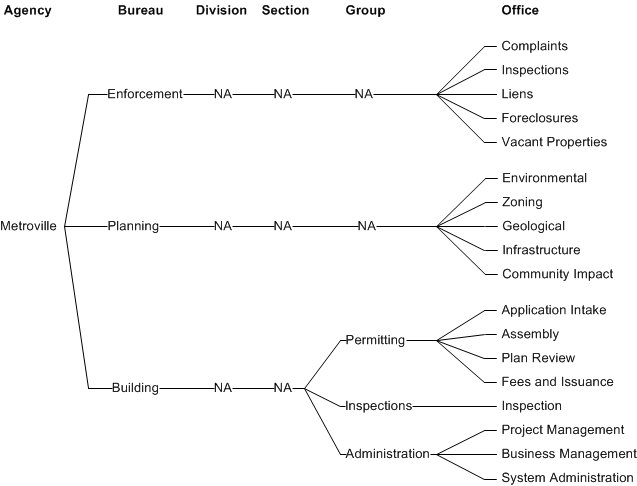Understanding Organization Structures
Civic Platform uses the following 7 level hierarchy to define organization structures:
Service Provider > Agency > Bureau > Division > Section > Group > OfficeService Provider. Civic Platform provides this value during your initial implementation. This unique code (also referred to as the serv_prov_code) distinguishes your agency from all other jurisdictions for which Civic Platform is the service provider. You cannot change this value. The service provider represents an individual Civic Platform system deployment.
Agency. You determine this value for one or more agencies that you set up. Civic Platform displays the agency as the first level of an organization structure for a department. Civic Platform uses the agency name as the agency ID when you log in to Civic Platform.
Bureau. An organization level within an agency.
Division. An organization level within a bureau.
Section. An organization level within a division.
Group. An organization level within a section.
Office. An organization level within a group. An office is the final level within an organization structure. You cannot add a branch to this organization level.
Department. The alias name used to represent the 7 level hierarchy that terminates at the office level (Understanding Departments).
In Civic Platform, a complete organizational structure includes all 7 levels. You can use an arbitrary designation, such as NA (Not Applicable), to indicate hierarchical levels of no meaning in your organization or of no practical use for setting up Civic Platform user groups and processes.
You can add branches to an existing organizational structure definition to create the number of discrete departments for which you want to apply different business processes.
Example Organizational Structure
A typical setup might develop as follows:
Add the first level to the main agency. Best practice is to match this level to the available modules, Building, Enforcement, Planning, for example.
Metroville > Enforcement
Metroville > Planning
Metroville > Building
The office level represents the terminal node of the organizational structure. You can only add one department for each office. Civic Platform associates many processes to departments, processes You can only add one department for each office.
Your choice for where to define organization branch structures, and where to use the NA placeholder, depends on how you want to associate Civic Platform processes with agency organizations, future expansion plans, and so forth. For best practice, define organization structures with the lowest level (office and group, for example) necessary to meet business needs. Reserve higher level organizational structures (section and division, for example) for future use.
An example organizational structure for a building module (Example Organization Structure) might be as follows:
Metroville > Building > NA > NA > Permitting > Application Intake
Metroville > Building > NA > NA > Permitting > Assembly
Metroville > Building > NA > NA > Permitting > Plan Review
Metroville > Building > NA > NA > Permitting > Fees and Issuance
Metroville > Building > NA > NA > Inspections > Inspections
Metroville > Building > NA > NA > Administration > Project Management
Metroville > Building > NA > NA > Administration > Business Management
Metroville > Building > NA > NA > Administration > System Administration
Example Organization Structure provides an example organization structure for the Metroville agency (Service Provide level not shown) The Enforcement, Planning, and Building modules represent the organization structure at the bureau level. For the Enforcement and Planning modules, no additional organization structures beyond the office level make sense. For the Building module, discrete organization processes revolve around permitting, inspections, and administration. Within each of these groups we define offices performing discrete functions within the group.
Figure: Example Organization Structure

Understanding Departments
Organization structures in Civic Platform provide the framework for applying different functions to departments and department members. You assign each user to exactly one department and to no more than one user group per module. Civic Platform processes that apply to a specific department apply to the individual users assigned to that department (the department members).
Civic Platform workflows typically assign tasks to departments, comprised of individuals with similar skill sets, to balance the task load and maximize task throughput.
The user group to which an individual user belongs, determines the user permission to act on a Civic Platform process assigned to their department. Different department members may have different permission due to their membership in a different user group. If an individual department member belongs to different module user groups with different permissions, the user group permissions defined for the module from which the department action request originated, applies.
Example Use Case
Grant full access to all Civic Platform functions for the agency administrator user group. Limit the desk clerk user group to specific activities, such as searching for an application.